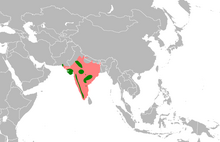Sypheotides
| Lesser florican | |
|---|---|
 |
|
| Scientific classification | |
| Kingdom: | Animalia |
| Phylum: | Chordata |
| Class: | Aves |
| Order: | Otidiformes |
| Family: | Otididae |
| Genus: |
Sypheotides Lesson, 1839 |
| Species: | S. indicus |
| Binomial name | |
|
Sypheotides indicus (Miller, 1782) |
|
 |
|
| Spot distribution map (includes historic records) | |
 |
|
| Overall distribution (reddish) and breeding areas (green) | |
| Synonyms | |
|
Sypheotis aurita |
|
Sypheotis aurita
The lesser florican (Sypheotides indicus), also known as the likh or kharmore, is a large bird in the bustard family and the only member of the genus Sypheotides. It is endemic to the Indian Subcontinent where it is found in tall grasslands and is best known for the leaping breeding displays made by the males during the Monsoon season. The male has a contrasting black and white breeding plumage and distinctive elongated head feathers that extend behind the neck. These bustards are found mainly in northwestern and central India during the summer but are found more widely distributed across India in winter. The species is highly endangered and has been extirpated in some parts of its range such as Pakistan. It is threatened both by hunting and habitat degradation. The only similar species is the Bengal florican (Houbarobsis bengalensis) which is larger and lacks the white throat, collar and elongated plumes.
A male in breeding plumage has a black head, neck and lower parts. However, his throat is white. Around three 4 inch long, ribbon-like feathers arise from behind the ear-coverts on each side of the head and extend backwards, curving up and ending in spatulate tip. The back and scapulars are mottled in white with V shaped marks. The wing coverts are white. After the breedings season, the male tends to have some white in the wing. The female is slightly larger than the male. The females and males in non breeding plumage are buff with black streaks with darker markings on the head and neck. The back is mottled and barred in black. The neck and upper breast are buff with the streaks decreasing towards the belly. The outer primaries of the males are thin and notched on the inner-web. The leg are pale yellow and the iris is yellow.
Young birds have a distinct U shaped mark on the neck near the throat.
The two species of smaller bustards have been called "floricans". The word has been thought to be of Dutch origin. The genus Sypheotides earlier included what is now Houbaropsis bengalensis (or Bengal florican), the two species being small and showing reverse sexual size dimorphism. The tarsus is long in Sypheotides and the seasonal plumage change in male has led to the retention of the separate genus, although the two genera are evolutionarily close. Male and female plumages were initially thought of as separate species leading to the names aurita and indica and the species has been placed in the past in the genera Otis, Eupodotis and Sypheotis. The species ending which is related to the gender of the Latin genus has been debated and it believed that indicus is correct.
...
Wikipedia

